A servo motor — also known as a servo — is an efficient and reliable motor you can control with precise movements with the right amount of desired output. The more you know about the systems and how they work, the more you’ll understand how to choose the right one for your specific application. When you need repairs, Global Electronic Services can assist with them and provide services for all types of servo motors.
What Is a Servo?
A servo motor is a system that rotates or pushes parts of a particular application or machine with precise movements. It’s an electronic device that’s self-contained with a direct current motor that runs on batteries. Because they have simple setups of direct or alternating current motors, potentiometers and control circuits, servos are energy efficient.
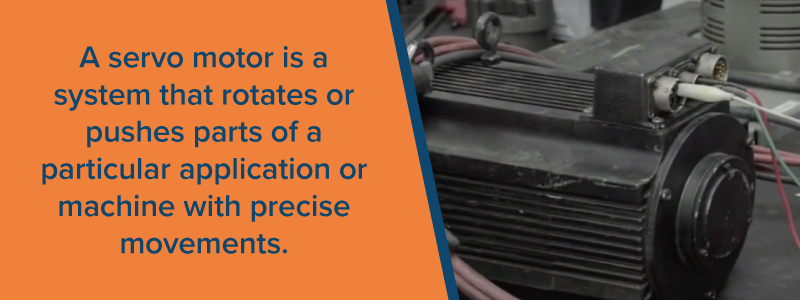
Two common sizes exist when it comes to the motor systems — standard and miniature, or small. While a standard servo can range in power and speed for various applications, a mini is about the size of a quarter. Many companies use smaller versions where limited space is more of a concern than having a lot of power.
By spinning at the desired rotation per minute, servos output low torque. If you apply gears, the high-speed output of the motor can slow down while increasing torque. Since a small motor has a lot of torque, yet can spin fast to create a small force with a lot of distance, gears can convert the system’s output to a slower rotation speed with more torque.
Small servos consist of plastic parts for small motors while larger ones are made of metal for more substantial work. Standard motor servos convert the low-power, fast motion of the motor to the output shaft. With automatic behavior characteristics, servos do not require assistance from an outside source to produce precise movements. Types of servo motors include the following:
- Continuous rotation servo
- Linear servo
- Positional rotation servo
How a Servo Motor System Works and How It’s Controlled
When determining the exact movements you want the system to produce, you must connect the servo motor to a power source. A control signal can come from a computer, radio or other circuitry to make a servo take commands from a series of pulses. A pulse is a low voltage that transitions to a high voltage. It stays up for a short time, then returns to low.

A low voltage of a servo motor means zero volts, while a high voltage is the full battery voltage. As servos range from about four to six volts, a pulse train for most models can range between 50 and 60 Hz. A motor’s pulse width varies between one millisecond to two or three milliseconds, which makes the system vital for applications that need defined position control.
Having servo motors that support your company is crucial for the proper running of specific applications. Controlled by a pulse-width modulator, the systems have a servo circuitry built inside the motor unit. It has a shaft you can position, and many businesses often fit them with gears. An electrical signal controls the motor to regulate the amount of shaft movement.
When the motor rotates, the potentiometers resistance changes, which means the control circuit can control the amount of movement and in which direction. As the shaft of the motor reaches the desired position, the power supplies stop. The position of the motor is sent in electrical pulses through a signal wire. The speed of the system is relative to the difference between the desired and actual position. When the motor is close to the position desired, it will slowly turn, which means it has proportional control.
Controlled by the sending of pulse width modulation — PWM — through a control wire, a servo has a minimum and maximum repetition and pulse rate. The motor often turns 90 degrees in one direction for a total of 180 degrees. However, the neutral position of a servo is where it has equal potential rotation in both directions.
To determine the position of the shaft, PWM is sent to the motor. Based on the duration of the pulse transmitted from the control system, the rotor will turn to your desired position. Universal servos expect a pulse every 20 milliseconds, and the length determines how far they’ll rotate. Servos move to the right place and stay put, even if an external force acts against them. But because the servo motor won’t stay in the same location forever, the position pulse has to be repeated, which will tell the servo to remain.
Common Applications of Servo Motors in Different Industries
From electric-powered cars, helicopters and airplane toys to robots, home electronics and Blu-ray disc players, servo motors can maneuver and control various applications. For machines that rely on accurate precision control, servo motors serve as efficient and compact devices. They support applications that require a repetitive task to be done in the same way each time, including:
- Automatic door openers: Automatic doors found at grocery stores, hospitals and other locations use servo motors systems via a push plate or radio transmitter above a door.

- Camera autofocus features: Servos built into cameras correct their lenses by sharpening out-of-focus images.
- Conveyor belts: The system can start, stop and move conveyor belts for any industry.
- Metal cutting and forming machines: Servos offer precise control movements for lathes, milling machines, centering, grinding, punching, bending and pressing metal, like for car wheels and jar lids.
- Positioning antenna tasks: Servos can position antennas and telescopes to their correct angles.
- Printers: Servos can start and stop the print heads working on a paper, and the system also moves the paper along.
- Robotic vehicles: Often used for military applications and bomb detonation, servo motors can control the wheels of a car as well as move, start and stop it with the right amount of torque at a controlled speed.
- Robotics: Companies use servo motor systems at every joint of a robot for precise movements.
- Solar tracking systems: The motors can adjust the angle of solar panels to face the sun, which will harness the most amount of energy.
- Textiles: Servos used for industrial spinning and weaving machines along with knitting and loom machines can create textiles such as carpeting and fabrics like socks, gloves and mittens.
- Woodworking: Servo motors control the accuracy of lathes.
Other uses include automated manufacturing and computer numerical control machinery. Servos can move levers to control the steering of vehicles and regulate the speed of aircraft and cars. If your company uses servo motors for robots, you’ll be able to control the entire machine — from rotating an arm and moving a leg to opening the eyes of a robotic person and lifting its eyebrows.
Used for manufacturing applications, servos can also position control surfaces like rudders, elevators and grippers. In the food service and pharmaceutical industries, servos are vital to resisting corrosion and other harsh environments.
Because you can implement servo motors in dozens of applications, it’s vital to understand which type is best for which situation.
How to Choose a Servo Motor for Your Company
Selecting the correct type of servo is not a black and white situation. You must consider various aspects to determine which model is best. For example, if your company needs to control a tiny toy, you may want to consider a smaller servo motor system as opposed to a standard size for heavier work like for a robot.
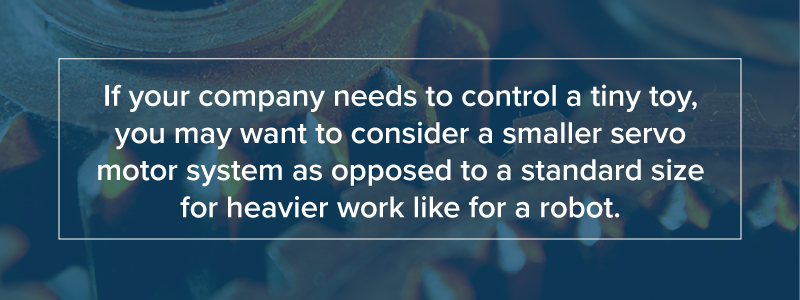
Begin by thinking about your application requirements, and consider the following:
- How hard does your company need it to push or pull?
- How much overshoot is allowable?
- What’s the load, speed and torque of the servo?
- What’s the servo’s running torque?
- What’s the speed of the servo from one position to another?
Answering these questions is an excellent starting point to go more in-depth with your requirements. When you figure out the inertia, voltage and power profile you need, you can invest in the right type of motor. The proper size will ensure not only superior performance output but also reliability.
Two kinds of motors exist — AC and DC. An AC motor, or an alternating current motor, can handle higher current and is often used for industrial machinery. A DC motor, or direct current, is ideal for smaller applications and not made for high-current surges. Both produce continuous rotation and have two ball bearings on the output shaft to reduce friction. The bearings also create easier access to the rest-point adjustment potentiometer.
When you take deceleration, acceleration and running torque into consideration, as well as the servo motor’s capability of regulating speed, position and torque, you will better understand which version makes more sense for your situation. Calculate peak, running and normal torque, too. Continuous torque produces rated torque and speed without overheating the system, and intermittent determines how much torque the motor can provide in a short time constructed. The peak torque can be higher than the rated number because systems operate well within the peak torque range.
While you can choose between two kinds of motors, there are three types of servo motor systems:
- Continuous rotation servo: A constant rotation servo turns in either direction for an infinite amount of time. The control signal is inferred as the direction and speed of rotation. Depending on the command signal, it rotates at varying speeds, and you can use it as a drive motor on a movable robot.
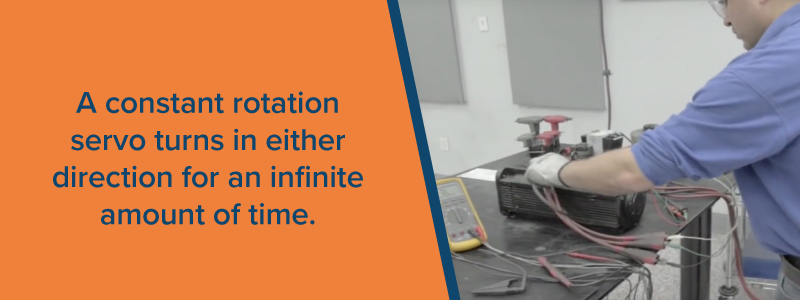
- Linear servo: A linear servo requires more gears than a positional servo and often has a rack and pinion mechanism. It changes the output from a circular motion to one that’s back and forth. Companies use linear servos as actuators in large model airplanes.
- Positional rotation servo: A positional rotation servo is the most common type out of the three options. With an output shaft that rotates 180 degrees, physical stops keep it from turning beyond the limits. The stops protect the rotational sensor, and businesses use the motors for radio-controlled cars, aircraft and toys.
Considerations about load, inertia and speed determine how far and fast the weight must travel. Calculating the torque occurs after you learn the weight and speed. Sizing software is another thing to think about, as different online tools can help determine the size that will best suit your company based on your application.
The steps and procedure on how to choose the ideal servo motor are as follow:
1. Conclude the drive mechanism for your equipment. For example, is it a ball screw, direct rotation, belt and pulley or rack and pinion? You’ll also want to define the dimensions, friction coefficient, mass and other factors required for load calculation, including:
a. Dimensions and mass of load and each part
b. The friction coefficient of each moving part
2.Figure out the necessary specifications for your application. Specific features can range from an open and closed loop, feedback and programmable to IP rating and agent approvals. Consider, for example:
a. Accuracy of stopping
b. Operating conditions
c. Operating speed and time
d. Positioning distance and time
e. Resolution
f. Voltage and power supply
3.Calculate torque, speed and inertia. Once you determine the required performance, you can select the right type of motor. The ideal servo motor system will have acceleration time and torque along with mechanical strength.

The size you select will affect other system components in your application and the servo motor. If you choose one that’s oversized, your company will need a loftier amplifier than required for a smaller motor, which will also result in higher costs and more energy requirements.
Common Servo Motor Issues You May Experience
Even with an excellent preventative maintenance schedule and the perfect environment, servo motors can still experience issues, like any other machine. Whether bearings become loose, dust contaminates the motor or the system has old electrical components, your business can face several common servo issues.
Despite regular upkeep, a servo motor can fail during operation, so your best bet is to ship it to the professionals like Global Electronic Services. One factor to consider is how much the environment plays a role in the condition of your motor — for example, if the area is dirty, humid or tough on the servo. Each is a significant factor affecting individual parts of the mechanism.
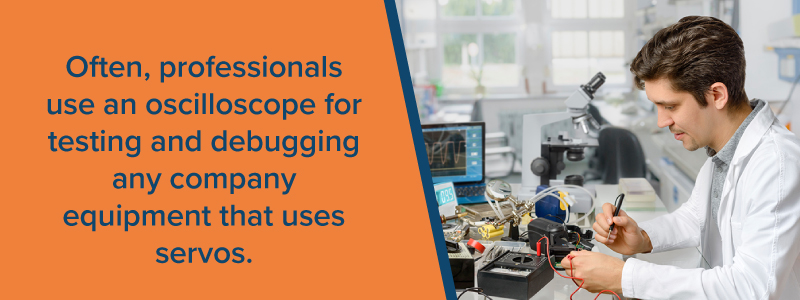
For a servo motor to be successful, it relies on all its parts working in unison. If a portion isn’t running at its premium level, it can affect the system or even your equipment. Often, professionals use an oscilloscope for testing and debugging any company equipment that uses servos. Well-known servo complications involve:
- Abnormal buzzing and high-frequency noises: Common culprits of sounds involve loose parts in a motor, loose bolts, worn bearings and a high GAIN setting. The buzzing noises often relate to a positioning error, set-up issue or loss of parameters. The first step of repair is to run through the set-up process. However, the servo could have a feedback error that will need to be repaired. A high-pitch noise can be the result of a bearing problem like dust on the brakes.
- Bad bearings that wear out over time: A natural occurrence, the wearing of bearings is something you can prevent or at least delay with scheduled preventative maintenance. This service is vital for long-lasting servo motors, and if you don’t schedule it, the motor’s life expectancy will be shorter. Trained mechanics will need to change the bearings and rebuild your company’s mechanism when bearings get worn out.
- Contaminated servo motor parts: If contaminants such as errant oil, cutting fluid or coolant reach the inside of a servo mechanism, the result can have devastating effects on the bearings, electronic components, encoder and windings.
- Damaged cable: If the servo has a shorted wire, it can cause improper voltage and ruin the motor. If more severe issues occur, they could impair your company’s equipment.
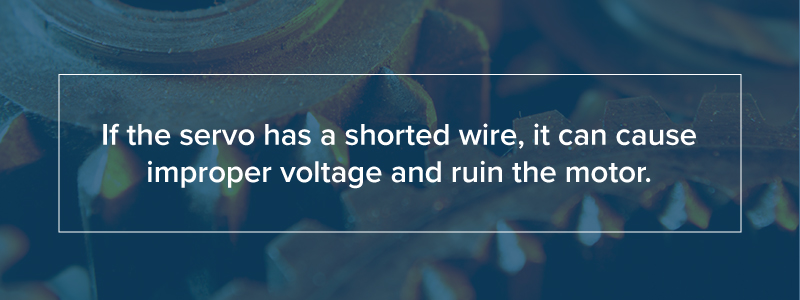
- Erratic operation like running with no control, running with reduced torque or the motor locking into position: Causes can relate to reversed sine, cosine or rotor leads or lead sets along with phases A and B, A and C or B and C reversing.
- Inadequate power supply or drive: When one of the two transpires, it can lead to a spike in voltage to a servo, which can cause damage.
- Machine overload: Like any machine, if a servo motor gets overworked, it won’t last as long. The harder the servo motor is running, the less time it will last for. However, you can reduce the chances of premature failing by scheduling maintenance and turning to experts for repairs.
- Lack of rotation: Inconsistent or lack of rotation can be due to worn out bearings, excessive motor load, foreign matter stuck in the motor or loose or open motor connections. Once the professionals determine which feature is causing the problem, it becomes a case of replacing bearings, cleaning components or tightening various connections.
- Overheating that can lead to failure of servo motor system and machine: Overheating can be the outcome of an excessive duty cycle where the motor voltage exceeds the maximum value. It could also be because of extreme motor current. If caused by an overcurrent, repair service professionals like Global can check out brake issues, mechanical binding and overload problems. We can also inspect the output shaft and windings.
- Electrical degradation: Electrical components like the resolver and feedback device encoder break down over time. If breakdown ensues, proper replacement is necessary.
While some servo system issues may be more common than others, taking your machine to the professionals will help reduce downtime for your company. Instead of waiting for your workers to stop hearing a constant noise or expecting the damaged cable to have no effect on your equipment, refer to expert technicians.
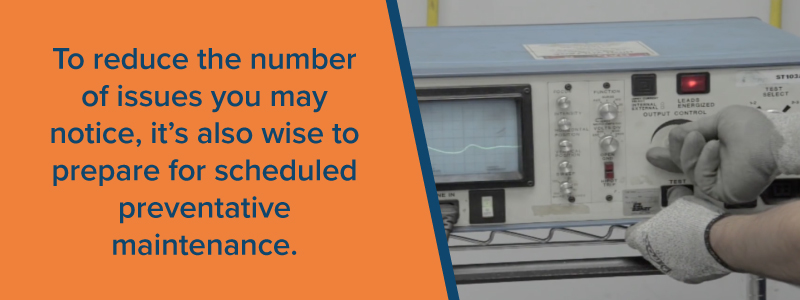
To reduce the number of issues you may notice, it’s also wise to prepare for scheduled preventative maintenance. This maintenance will keep your business’s servo motors running long-term and help reduce more severe problems in the future. If you don’t take care of your motors on a regular basis, it can lead to the destruction of your machines and decrease the uptime of your company.
Global Electronic Services and Your Servo Motor Repairs
Taking a more in-depth look at servo motors can help you invest in the right size and type of system. Knowing more about the motor can also help you use it for the correct applications, whether your company develops robots, builds toys or creates remote control cars.
If you’re experiencing one or more of the common issues that can occur with your servos, Global Electronic Services is here to get you back on track. While fixing minor damages may work well in-house, bringing your servo motor to the professionals will result in a fine-tuned system ready for consistent work.
Our factory trained and certified technicians can repair and service every type of servo motor. We work hard to support more than 60,000 of the largest, most advanced manufacturers and distributors in the world. We also beat any competing price by 10 percent. With Global Electronic customer service available 24/7, we offer an 18-month in-service warranty and provide a repair time of one to five days. Our services minimize your company’s downtime and improve your bottom line.
If you want to learn more how we can repair or service your servo motor, contact us online or fill out a request a quote form. You can also call 877-249-1701 to speak with a Global Electronic Services representative.
